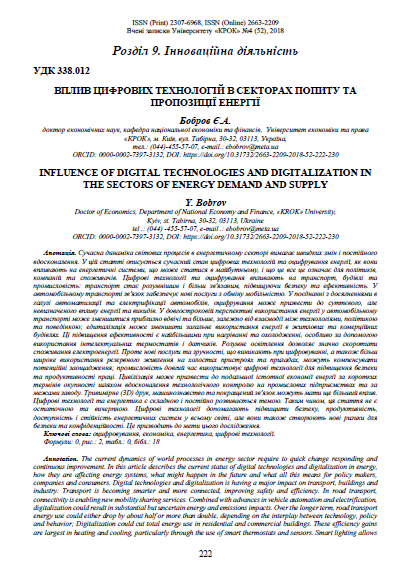INFLUENCE OF DIGITAL TECHNOLOGIES AND DIGITALIZATION IN THE SECTORS OF ENERGY DEMAND AND SUPPLY
DOI:
https://doi.org/10.31732/2663-2209-2018-52-222-230Keywords:
digitalization, digital technology, economy, energyAbstract
The current dynamics of world processes in energy sector require to quick change responding and continuous improvement. In this article describes the current status of digital technologies and digitalization in energy, how they are affecting energy systems, what might happen in the future and what all this means for policy makers, companies and consumers. Digital technologies and digitalization is having a major impact on transport, buildings and industry: Transport is becoming smarter and more connected, improving safety and efficiency. In road transport, connectivity is enabling new mobility sharing services. Combined with advances in vehicle automation and electrification, digitalization could result in substantial but uncertain energy and emissions impacts. Over the longer term, road transport energy use could either drop by about half or more than double, depending on the interplay between technology, policy and behavior; Digitalization could cut total energy use in residential and commercial buildings. These efficiency gains are largest in heating and cooling, particularly through the use of smart thermostats and sensors. Smart lighting allows for potentially substantial cuts in lighting electricity demand. However, new services and comforts brought about by digitalization – as well as greater use of standby power by idle devices and appliances – could offset potential savings; Industry has been using digital technologies for a long time to improve safety and productivity. Digitalization could lead to further significant energy savings with short payback periods through improved process controls within industrial plants and beyond the plant fence. Three-dimensional (3D) printing, machine learning and enhanced connectivity could have an even bigger impact. Digital technologies and energy is a complex and constantly evolving topic. As such, this article is not definitive and exhaustive. Digital technologies are help to increase the security, performance, availability and sustainability of energy systems around the world, but they also create new risks for security and confidentiality. This leads to the purpose of this research.
Downloads
References
Annunziata M. et al. (2016). Powering the Future: Leading the Digital Transformation of the Power Industry. GE.
Abuelsamid S., Alexander D., and Jerram L. (2017). Navigant Research Leaderboard Report: Automated Driving. www.navigantresearch.com/wp-assets/brochures/LB-NGBC-16-Executive-Summary.pdf.
Cotteller M., and Joyce J. (2014). “3D opportunity: Additive manufacturing paths to performance, innovation, and growth”. https://dupress.deloitte.com/dup-us-en/deloitte-review/issue-14/dr14-3d-opportunity.html.
Fulton L., Mason J., and Meroux D. (2017). Three Revolutions in Urban Transportation. Davis, CA. https://steps.ucdavis.edu/wp-content/uploads/2017/05/ITDP-3R-Report-v6.pdf.
Grözinger J., et al. (2017). “Optimising the energy use of technical building systems – unleashing
the power of the EPBD’s Article 8”. Ecofys, www.ecofys.com/files/files/ecofys-2017-optimisingthe-energy-use-of-tbs-final-report.pdf.
Horner N. C., Shehabi A., and Azevedo I. L. (2016). “Known unknowns: Indirect energy effects of information and communication technology.” Environmental Research Letters , 11(10), 103001.
Huang R. (2016). A Multi-Scale Life Cycle Framework for the Net Impact Assessment of Additive Manufacturing in the United States. Northwestern University.
Huang R., et al. (2017). “Cost minimization in metal additive manufacturing using concurrent structure and process optimization”. Proceedings of the ASME 2017 International Design Engineering Technical Conference & Computers and Information in Engineering Conference IDETC2017. http://vdel.me.cmu.edu/publications/2017dac/paper.pdf.
Huang R., et al. (2016). “Energy and emissions saving potential of additive manufacturing: the case of lightweight aircraft components”. http://doi.org/10.1016/j.jclepro.2015.04.109.
Kofod C. (2016). Smart Lighting – New Features Impacting Energy Consumption First Status Report. IEA 4E Solid State Lighting Annex Task 7. http://ssl.iea-4e.org/files/otherfiles/0000/0085/SSL_Annex_Task_7_-_First_Report_-_6_Sept_2016.pdf.
Larson W., and Zhao, W. (2017). “Telework: Urban form, energy consumption, and greenhouse gas implications”. Economic Inquiry, 55(2), 714–735. http://doi.org/10.1111/ecin.12399.
Masanet E., et al. (2017). “Leveraging smart system technologies in national energy data systems: Challenges and opportunities”. Energy and Economic Growth State-of-Knowledge Paper Series; working paper.
Pye S. and Dobbins, A (2015). “Energy poverty and vulnerable consumers in the energy sector across the EU: Analysis of policies and measures”. https://ec.europa.eu/energy/sites/ener/files/documents/INSIGHT_E_Energy%20Poverty%20-%20Main%20Report_FINAL.pdf.
Zimmer J. (2016). The Third Transportation Revolution Lyft’s Vision for the Next Ten Years and Beyond. https://medium.com/@johnzimmer/the-third-transportation-revolution-27860f05fa91.
Zimmer J., and Green, L. (2017). Lyft Climate Impact Goals. https://blog.lyft.com/posts/2017/6/14/lyft-climate-impact-goals.
Key Marketing Trends for 2017. IBM Marketing Cloud. www-01.ibm.com/common/ssi/cgi-bin/ssialias?htmlfid=WRL12345USEN.
Cisco Visual Networking Index: Forecast and Methodology, 2016-2021.
Fortune Global 500 List 2017. http://fortune.com/global500.


